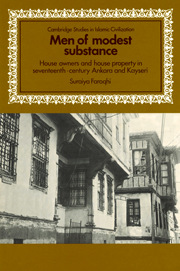Book contents
- Frontmatter
- Contents
- Tables
- Graphs
- Illustrations
- Figures
- Abbreviations
- Preface
- Introduction
- 1 Setting the scene: two cities of central Anatolia
- 2 The physical shape of urban houses
- 3 The cost of buying a house
- 4 Urban property-owners
- 5 The difficulties of an urban property-owner
- Conclusion
- Glossary
- Notes
- Bibliography
- Index
- Frontmatter
- Contents
- Tables
- Graphs
- Illustrations
- Figures
- Abbreviations
- Preface
- Introduction
- 1 Setting the scene: two cities of central Anatolia
- 2 The physical shape of urban houses
- 3 The cost of buying a house
- 4 Urban property-owners
- 5 The difficulties of an urban property-owner
- Conclusion
- Glossary
- Notes
- Bibliography
- Index
Summary
The term ‘Ottoman architecture’ evokes the image of stately structures, built mainly in the fifteenth and sixteenth centuries upon the initiative of the reigning Sultans, members of their families, and high-ranking public officials. İstanbul, Bursa and Edirne contain the most monumental specimens of this type of architecture, mainly mosques, theological schools, fountains, and structures used for commercial purposes. Outside the borders of modern Turkey, the downtown area of Aleppo still bears witness to the construction activities of Ottoman provincial administrators, and Damascus or Sarajevo also feature many buildings characteristic of an Ottoman city. In fact, most towns which at one point in their existence formed part of the Ottoman Empire still contain at least one mosque or public bath representing the ‘classical’ Ottoman style of the sixteenth century. Large blocks of stone, perfectly regular in shape, a central dome covered with lead, and elaborate stalactite arrangements, may be mentioned among the most obvious characteristics of this type of architecture.
Next to these monumental buildings, the domestic architecture of Ottoman towns has always figured as a poor relation. For the period before the nineteenth century, even palace architecture is represented only by a limited number of examples: the Topkapı, Hünkâr Kasrı, and Ibrahim Paşa palaces in İstanbul, in addition to a few vestiges remaining from the Sultans' palace in Edirne. With certain reservations, the architecture of the more important dervish lodges (zaviyes), such as the complex of Mevlâna Celâddin Rumî in Konya, or the hospice of Seyyid Gazi near Eskişehir, might be regarded as comparable to palace architecture; but the number of surviving major zaviye complexes is also quite limited.
- Type
- Chapter
- Information
- Men of Modest SubstanceHouse Owners and House Property in Seventeenth-Century Ankara and Kayseri, pp. 1 - 22Publisher: Cambridge University PressPrint publication year: 1987



